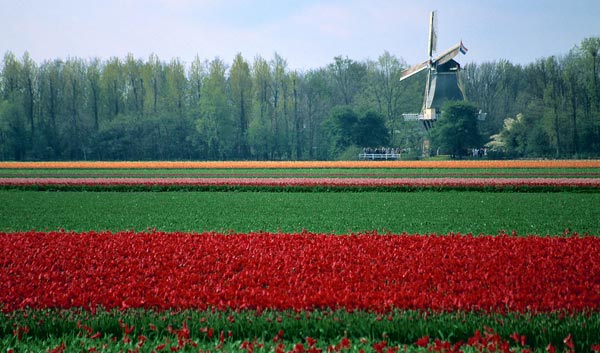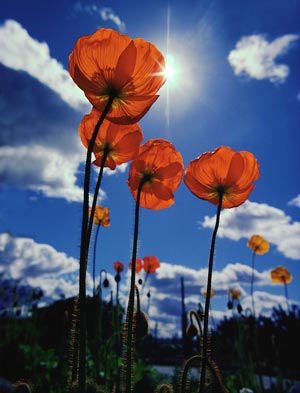Flowers grow all over the world, so I’m not surprised when people ask me where the flowers sold in florist shops or supermarkets come from and how they get from those faraway places to markets across the United States and Canada. Those are great questions, and the frequency of the queries indicates the high level of interest people have about flowers.

Holland is a primary grower of flowers.
Flowers Grow in Three Main Places
About 90 percent of all flowers sold in the U.S. and Canada come from just three places: Colombia (70 percent), Ecuador (10 percent) and California (10 percent.) The sources of the remaining 10 percent include countries such as Canada, Holland, Mexico, South Africa, Kenya, Ethiopia and Thailand.
How a Cut Flower Is Shipped

Flowers grow mostly in warm countries.
Step 1: Preparation
With some exceptions, most flowers are cut, bunched, wrapped and then packed in large corrugated boxes for shipping. Those flower boxes coming from other countries (with the exception of Canada and Mexico) are placed on pallets and flown to the United States.
Miami is by far the largest destination for those flower boxes, but Los Angeles Airport and New York’s JFK Airport receive flowers, as well.
Step 2: Inspection
When boxes arrive in the U.S. from where the flowers grow around the world, they are inspected by the Department of Agriculture to make sure they are bug-free and also checked by U.S. Customs. Flower boxes are then delivered to flower importers who load the boxes on refrigerated trucks that deliver the flowers to local markets across the U.S. and Canada.
Step 3: Refrigerated Transportation
In the case of Californian-, Canadian- and Mexican-grown product, boxes of cut flowers are loaded onto refrigerated trucks to be shipped to local North American markets.
Because flowers are a very perishable cargo, those in charge of shipping and distributing them keep the stems at low temperatures (ideally around 35 degrees Fahrenheit) through every step of the distribution logistics process. This procedure is called the “cool chain.” It is the same type of procedures used for shipping other perishables, such as fruits, vegetables, poultry, meat, fish and pharmaceuticals.

Flowers require great care during shipping.
All of these efforts are designed to increase the enjoyment of fresh flowers whenever and wherever they are purchased.
Written by
Terry Johnson
PS: If you enjoyed this article, help spread the word by clicking the “Like”, “Tweet”, “+1” buttons or sharing it using the share icons below. Want to read more articles like this? Then Subscribe, and get our articles directly to your inbox or RSS reader.
Related posts:






Continue reading...

Holland is a primary grower of flowers.
About 90 percent of all flowers sold in the U.S. and Canada come from just three places: Colombia (70 percent), Ecuador (10 percent) and California (10 percent.) The sources of the remaining 10 percent include countries such as Canada, Holland, Mexico, South Africa, Kenya, Ethiopia and Thailand.
How a Cut Flower Is Shipped

Flowers grow mostly in warm countries.
With some exceptions, most flowers are cut, bunched, wrapped and then packed in large corrugated boxes for shipping. Those flower boxes coming from other countries (with the exception of Canada and Mexico) are placed on pallets and flown to the United States.
Miami is by far the largest destination for those flower boxes, but Los Angeles Airport and New York’s JFK Airport receive flowers, as well.
Step 2: Inspection
When boxes arrive in the U.S. from where the flowers grow around the world, they are inspected by the Department of Agriculture to make sure they are bug-free and also checked by U.S. Customs. Flower boxes are then delivered to flower importers who load the boxes on refrigerated trucks that deliver the flowers to local markets across the U.S. and Canada.
Step 3: Refrigerated Transportation
In the case of Californian-, Canadian- and Mexican-grown product, boxes of cut flowers are loaded onto refrigerated trucks to be shipped to local North American markets.
Because flowers are a very perishable cargo, those in charge of shipping and distributing them keep the stems at low temperatures (ideally around 35 degrees Fahrenheit) through every step of the distribution logistics process. This procedure is called the “cool chain.” It is the same type of procedures used for shipping other perishables, such as fruits, vegetables, poultry, meat, fish and pharmaceuticals.

Flowers require great care during shipping.
All of these efforts are designed to increase the enjoyment of fresh flowers whenever and wherever they are purchased.
Written by
Terry Johnson
PS: If you enjoyed this article, help spread the word by clicking the “Like”, “Tweet”, “+1” buttons or sharing it using the share icons below. Want to read more articles like this? Then Subscribe, and get our articles directly to your inbox or RSS reader.
Related posts:
- Ecuador Rose Grower Nurtures Flowers With Love
- Flower Grower to Consumer in 24 hours: FloraHolland
- How to Make Sugar-Frosted Flowers
Continue reading...

